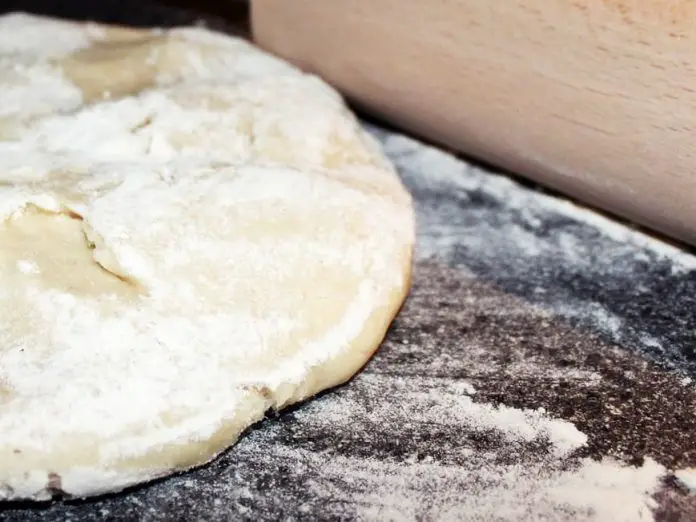Pizza is everybody’s best friend. Even our dogs love it. However, store-bought pizza can be as bad for dogs as it is for humans. Traditionally, pizza is served with lots of cheese and processed meats as toppings that can upset dog’s stomach.
The best kind of pizza for dogs is one made from scratch at home because you can control what to put or not to put as toppings. Takeout pizza usually has lots of onions that can harm your dog. Besides, making your own pizza is the best way to ensure it is healthy for your pup. Simply replace pepperoni with slices of chicken meat and limit the amount of cheese.
It is easy to find alternatives for the toppings and the sauce. So what about the crust? We all know it takes time to make pizza dough and if you have no penchant for baking then you might as well buy one from the supermarket. Is it too ambitious to create your own pizza crust? Maybe not, especially if you are doing it for your dog.
How is pizza crust made?
Before we tackle why it is better to create your own pizza dough, you should know why ordinary crust is not as wholesome as it looks like. The basic pizza dough uses four main ingredients: flour, water, yeast, and salt.
The kind of flour mostly used for the dough is white flour, which underwent refinement. Around six layers of the outer part of the wheat grains are stripped off during the refining process. This also means certain vitamins and minerals are already removed from the whole wheat grains. Given that, is white flour good enough for canines?
Dr. Edward Group, the founder of Global Healing Center, said the iron added to enriched flour is considered to be metallic iron, a type of iron that is not meant to be consumed, however, it is used in many consumer goods, including breakfast cereals.
Dogs need iron for their red blood cells to work as they should. The daily iron requirement for canines is 36.4 mg per day for every pound of dry food they consume. Without sufficient iron, your dog may develop anemia.
Like humans, dog should get their iron from natural sources, such as red meat, vegetables, and egg yolk, not from meals with food-grade iron fillings. There is a huge difference between metallic iron and nutritional iron.
Metallic iron is also known as reduced iron, meaning it was already fortified. What happens before food undergoes fortification? The nutritional value from the food is stripped down. Would you settle for anything less for your pup’s nutrition? Of course not!
Is it better to use whole-wheat flour for pizza?
Yes, as long as the baking is done right otherwise, you will have a flavorless crust with a very dry texture. Whole-wheat flour is not commonly used for making pizza because of its bad reputation. Many people who tried making dough from whole-wheat flour never tried it again because they ended up disappointed with the outcome. When the baking is done wrong, your pizza might have a slightly bitter taste and harsh feel on the mouth. On a positive note, there is actually a process you can follow to create a surprisingly delicious whole-wheat pizza crust.
Supposing you want to use whole-wheat flour, you could avoid having a flavorless pizza by using 50 percent of it and 50 percent of white flour. If you want to want to use pure whole-wheat flour, you may add a bit of sugar to tenderize your dough and extra virgin olive oil to give it a better taste.
Unless your dog does not have wheat allergies, it is perfectly fine to combine flours or use it entirely for your dough. What can you do if your dog developed allergies to wheat? Take a look at some of the best alternatives to flour below.
Dog-friendly Pizza Crust Alternatives
1.Cauliflower – when used for making pizza crusts, cauliflower gives the dough a combination of cracker and grits texture. If you are on a gluten-free diet, you might find cauliflower as the best substitute to wheat flour by ricing cauliflower or putting it in a processor until it looks like grain. The secret to a delicious cauliflower pizza crust is adding a bit of shredded mozzarella, beaten egg, dried oregano, and kosher salt. You may skip the minced garlic if you are worried it may harm your dog.
2.Zucchini – another grain-free alternative, zucchini will give you a bread-like crust. It feels like you are eating quiche or a baked tart with a savory filling. You will only need five ingredients to make a basic zucchini crust. Aside from the shredded zucchini, you will also need tapioca starch, egg, mozzarella cheese, and Parmigiano-Reggiano cheese. The zucchini should be squeezed dry for the pizza to crisp up.
3.Carrot – an entire carrot crust only has 237 calories while only a slice of white-flour crust already has 120 calories. A pizza crust made from carrots is a nutritious source of protein, fat, and carbohydrates. Carrots are not just a healthy alternative for pizza crusts. They can also be pureed to use as substitute for tomato sauce.
4.Spinach – contrary to myths, spinach is actually a great addition to a dog’s diet. Many dog owners are afraid of giving spinach to their dogs being afraid that the oxalates in it may cause their pets kidney problems. Truth is, it will take very large amounts of spinach to cause damage. However, making a spinach crust for your doggie’s pizza should not be a problem. Spinach is an excellent source of vitamins and minerals like iron and vitamin K. You may add a teaspoon of basil and oregano to make a healthier crust.
5.Sweet potato – like carrots, sweet potatoes can also be used not just for the toppings but also for making your crust. You will need to add a cup of almond flour and a bit of baking soda and salt in order to achieve a desirable taste. Simply combine these ingredients with mashed sweet potatoes.
6.Broccoli – the process of making a broccoli crust is the same as the one for making the cauliflower crust. You have to take the head and rice it in a food processor until it resembles rice grain. You may skip the garlic powder and simply use salt to give it flavor. For a more nutritious pizza crust, you may add a bit of basil, oregano, and olive oil. This low-carb and gluten-free crust actually tastes great.
7.Eggplant – who would think eggplant can be a healthy and delicious alternative to the typical pizza crust? To tame the natural bitter flavor of eggplant, it should be salted for around 15 minutes. Doing this also draws the moisture excess from the eggplant. Given that your pup does not have allergies to eggplants, you can safely give him some, but in moderation.
8.Butternut squash – butternut squash can actually help canines with their overall digestion because of its fiber content. This veggie is not just delicious, but also packed with vitamin A, magnesium, and potassium. When making a crust using butternut squash, the vegetable should be cubed and mashed. Some recipes out there have quite a lot of ingredients, which include grated cheese, sage, kosher salt, baking powder, ground nutmeg, cayenne pepper, and granulated garlic. You have to omit the last three ingredients because they can be toxic for your dog.
9.Quinoa – this gluten-free alternative will give your pizza a refreshing twist. It is crispy on the outside but there is a slight softness in the middle. Just like how quinoa normally tastes like, your crust will have a bit of nutty flavor. Also, just like how you would always prepare quinoa, it should be soaked in water to get rid of the soapy taste before making it a pizza crust. Quinoa is a complete protein and it is an excellent source of fiber, manganese, and magnesium.
10.Chickpea – aside from the chickpea flour, you will only need three ingredients for the crust: garlic powder, salt, and water. But because garlic powder can be harmful for dogs, it is best to skip that one. All you have to do is whisk them all together in a bowl. If you want to give your crust extra flavor, you may brush a bit of olive oil on the crust once it is done.
Other than the ones mentioned above, you may also use waffles and pita bread as pizza crusts. If you have an electric waffle maker, you can create a dog-friendly waffle in as fast as 15 minutes. For the pita bread, there are varieties that use oat bran and whole-wheat flour and you can easily find them in local supermarkets.
Conclusion
Pizza crust is fine for dogs, as long as they do not have wheat allergies. In case your dog is hypersensitive to wheat-based products, you can experiment in the kitchen and make your own dough. There are a lot of vegetable-based pizza crust recipes out there that are easy to make!























